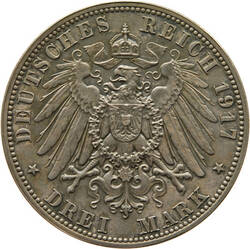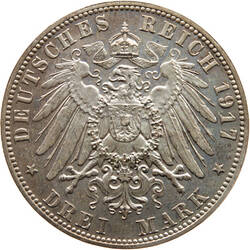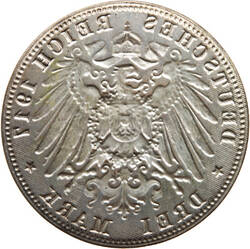This coin is a genuine rarity. It was minted in 1917, during the First World War. Silver was in short supply at the time, which is why only a hundred of these coins were struck. Most were probably melted down again. Which means that this is one of the German Empire's rarest coins.
It is also Saxony's last commemorative coin. From the 16th century onwards, the state's princes regularly minted coins on which events linked to a particular religion or denomination were depicted – particularly the Reformation. Once every hundred years, the rulers commemorated Luther's posting of his theses in Wittenberg on the 31st of October 1517. Saxony was the state where the Reformation had originated, and so in 1917, it was given permission to celebrate the 400th anniversary by issuing this commemorative three-mark coin.
It shows a portrait of the Saxon Elector Friedrich the Wise. Normally, a coin would bear the portrait of the current ruler, but not in this case. Since the mid-18th century, all the rulers of Saxony had been from the Roman Catholic Albertine line, including the last of them, King Friedrich August the Third, who commissioned this coin.
The designer was Friedrich Wilhelm Hörnlein, engraver at Saxony's state mint in Muldenhütten. He'd originally proposed a standing figure of Martin Luther, but that design was rejected. So Hörnlein opted for a portrait of Luther's most important patron, Elector Friedrich the Wise. The design was based on a "Schautaler", a display medal struck in Nuremberg in 1522.
Further Media
- Location & Dating
- 1917
- Material & Technique
- silver, embossed
- Dimenions
- Diameter: 33,1 mm; weight: 16,58 g
- Museum
- Münzkabinett
- Inventory number
- 1918/326


